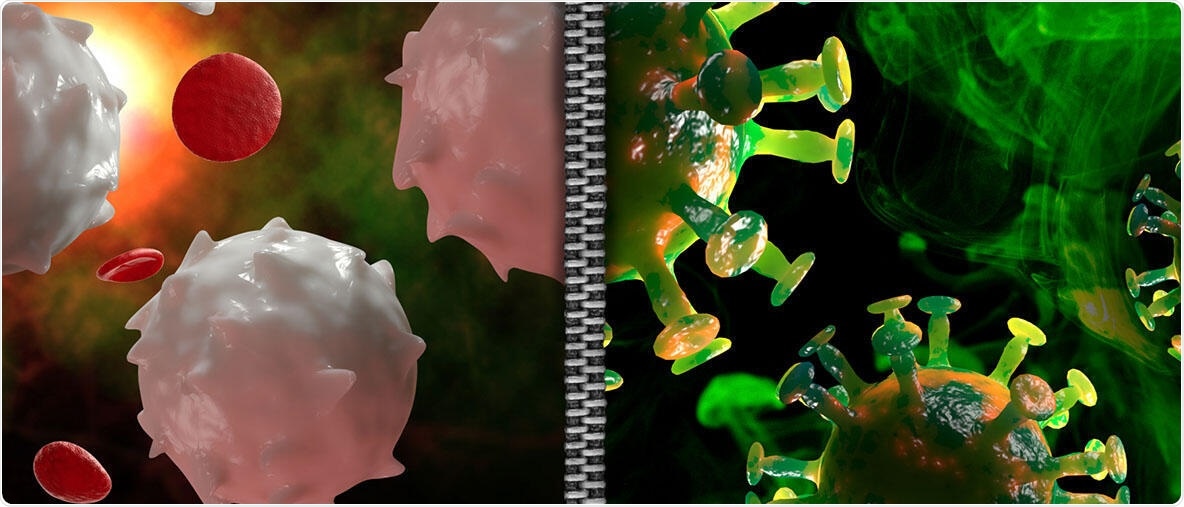A research team from Aalto University and the University of Helsinki has created an artificial intelligence (AI) technique that can bind immune cells to their targets and, for instance, uncouple the types of white blood cells that identify SARS-CoV-2.

Image Credit: Mostphotos.
The newly developed AI tool has a wide range of applications in interpreting the role of the immune system in cancer, infections, and autoimmune diseases.
In humans, the immune defense is based on the potential of white blood cells to precisely detect disease-causing pathogens and to trigger a defensive response against them. The immune defense is able to remember the microbes it has previously encountered, and this mechanism is used to determine the efficacy of vaccines, for instance.
Therefore, the immune defense is the most reliable patient record system, carrying a history of all pathogens faced by an individual. But acquiring this detail from patient samples turned out to be historically challenging.
The learning immune system can be somewhat split into two parts—that is, T cells and B cells. While B cells are responsible for generating antibodies against pathogens, T cells are responsible for killing their targets. Traditional laboratory techniques used for measuring antibodies are quite simple and this is the reason why antibodies already have many applications in the healthcare sector.
Although it is known that the role of T cells in the defense response against for example viruses and cancer is essential, identifying the targets of T cells has been difficult despite extensive research.”
Satu Mustjoki, Professor, Translational Hematology, University of Helsinki
AI helps to identify new key-lock pairs
T cells use a lock and a key concept to recognize their targets—the key is the T cell receptor on the T cell’s surface and the lock is the protein found on the surface of an infected cell. A person is believed to carry more different T cell keys than the number of stars found in the Milky Way, thus making it difficult to map the T cell targets through laboratory methods.
Scientists from Aalto University and the University of Helsinki have already profiled key-lock pairs and, hence, were able to develop an AI model that can estimate the targets for previously unmapped T cells.
The AI model we created is flexible and is applicable to every possible pathogen - as long as we have enough experimentally produced key-lock pairs. For example, we were quickly able to apply our model to coronavirus SARS-CoV-2 when a sufficient number of such pairs were available.”
Emmi Jokinen, MSc and PhD Student, Aalto University
The study results reveal how a T cell uses various parts of its key to detecting its locks. The team investigated which T cells detect the common viruses, including HI-, influenza-, and hepatitis B- virus.
The investigators also applied their tool to examine the function of T-cells in identifying hepatitis B, which had lost their ability to kill after hepatitis progressed to hepatic cell cancer. The research work was recently published in the PLOS Computational Biology journal.
A new life for published data with novel AI models
The AI-generated tools are cost-effective research topics.
With the help of these tools, we are able to make better use of the already published vast patient cohorts and gain additional understanding of them.”
Harri Lähdesmäki, Professor, Computational Biology and Machine Learning, Aalto University
The researchers used the AI tool and determined, among other things, how the intensity of the defense response is associated with its target in various states of disease, which would not have been feasible without this research work.
“For example, in addition to COVID19 infection, we have investigated the role of the defense system in the development of various autoimmune disorders and explained why some cancer patients benefit from new drugs and some do not,” revealed M.D. Jani Huuhtanen, a Ph.D. student from the University of Helsinki, about the forthcoming work of the latest model.
Source:
Journal reference:
Jokinen, E., et al. (2021) Predicting recognition between T cell receptors and epitopes with TCRGP. PLOS Computational Biology. doi.org/10.1371/journal.pcbi.1008814.